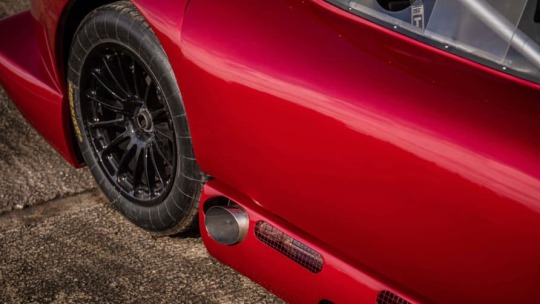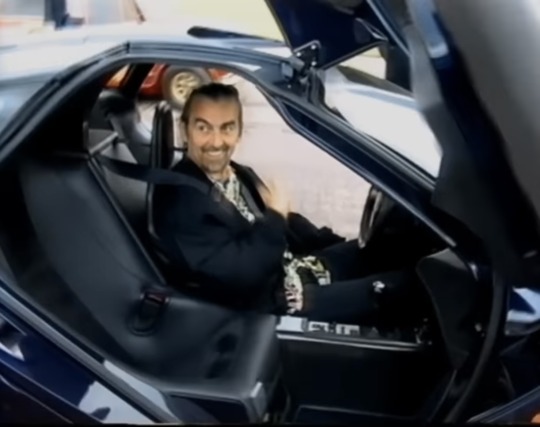#Gordon Murray Design
Explore tagged Tumblr posts
Text





Toyota Sera, 1990. First shown as the AXV-II concept (which was very close to production ready) the Sera was a Japanese market only coupé based on the platform of the Paseo and Starlet. The Sera's butterfly doors were hinged at the top centre of the windscreen, and bottom of the A pillar to open forward and up in a similar manner to the McLaren F1 - the F1's designer Gordon Murray has cited the Sera as the inspiration of the McLaren's door configuration. Many have subsequently been exported from Japan, primarily to other right-hand-drive markets (no left-steer Seras ever left the factory). It was not directly replaced when it was discontinued in 1995
#Toyota#Toyota Sera#1990#butterfly doors#1990s#special edition#JMD#Japanese Market#small coupé#small car
231 notes
·
View notes
Text
As today is the 49th anniversary of the sinking of the Mighty Fitz, I wanna talk about the facts of what happened. I've been hyperfixated on this shipwreck for a full year now, so if you'd like to learn more about it, please keep reading.
I feel that a good way to present this is with the Gordon Lightfoot song as an outline, as it's what most people are familiar with. When it was written in November and December of 1975 after Lightfoot heard about the disaster, he felt that it was his moral obligation to get the facts of the event as correct as possible. However, an official investigation would not take place until May of 1976 - it was delayed due to weather conditions - months after the song was recorded. That is why his guitarist Terry Clements convinced Lightfoot to do what his favorite author (Mark Twain) would have done; tell a story.
Superior, they said, never gives up her dead when the skies of November turn gloomy. Lake Superior is the largest body of freshwater on the planet, able to fit the other four Great Lakes inside of her. She’s also the deepest, with the average depth being close to 500 ft and the deepest point being 1,332 ft deep. It is also the coldest Great Lake, the bottom clocking in at a frigid 32 degrees Fahrenheit, making it just a hair above freezing. Because of this, that means that it is too cold for bacteria to grow and makes it impossible for bodies to undergo decomposition. So, instead of float to the surface as they would in other bodies of water, the bodies of Lake Superior instead sink and remain frozen in time. As of the time that this is being written, there has only been one body found from the crew of the SS Edmund Fitzgerald. It was because of the discovery of this crewman that the wreck site has been designated as a graveyard and dives to the shipwreck have been severely restricted.
The ship was the Pride of the American Side… The Edmund Fitzgerald had many nicknames: “The Mighty Fitz”, “The Pride of the American Side”, “The Singing Ship”, just to name a few. “The Pride of the American Side” was given to her due to her size. When she was built in 1957, the specs of the ship were made so that it would challenge those of all other freighters. She would break shipping records throughout her entire career; six times, to be exact, often breaking her own records. She was given the name “The Singing Ship” because her third captain, Captain Peter Pulcer, would play music over her loudspeakers for boat watchers to enjoy, even going out on deck with a megaphone to give off facts about the ship - such as where it was headed and what it was hauling. Her fourth captain, Captain Ernest McSroely, took command in 1972. He would remain captain through the rest of her career.
As big freighters go, it was bigger than most… The specs of the Mighty Fitz were 729’ in length, with a depth of 39’ and a draft (how much of the ship is submerged in water) of 25’. She was given such a specific length so that she could just fit in the Soo Locks - the engineering marvel that connects the Huron and Superior lakes in Sault Ste Marie, MI (pronounced “soo saint Marie”) - which had a max length of 730’. She was the largest ship on the Lakes (earning her the title “Queen of the Lakes”, a title passed on to whichever ship is the largest sailing the Lakes) until the SS Murray Bay was launched, beating her out by a foot of length. However, despite her hulking size, she was one of the fastest freighters to sail the freshwater, her top speed clocking in at 14 knots (~ 16 mph). A very impressive speed when you take into account that she weighed 13,632 tons with an empty cargo hold.
With a crew and good captain well seasoned… It took 29 men to sail the Mighty Fitz. Michael Armagost, 37, third mate. Frederick Beetcher, 56, porter. Thomas Bentson, 32, oiler. Edward Bindon, 47, first assistant engineer. Thomas Borgeson, 41, maintenance man. Oliver Champeau, 41, third assistant engineer. Nolan Church, 55, porter. Ransom Cundy, 53, watchman. Thomas Edwards, 50, second assistant engineer. Russell Haskell, 40, second assistant engineer. George Holl, 60, chief engineer. Bruce Husdon, 22, deck hand. Allen Kalmon, 43, second cook. Gordon MacLellan, 30, wiper. Joseph Mazes, 50, special maintenance man. John McCarthy, 62, first mate. Ernest McSorely, 63, captain. Eugene O’Brain, 50, wheelsman. Karl Peckol, 20, watchman. John Poviach, 50, wheelsman. James Pratt, 44, second mate. Robert Rafferty, 62, steward. Paul Riippa, 22, deck hand. John Simmons, 63, wheelsman. William Spengler, 59, watchman. Mark Thomas, 21, deck hand. Ralph Walton, 58, oiler. David Weiss, 22, cadet. Blaine Wilhelm, 52, oiler. These are the names of all 29 men who went down with the Edmund Fitzgerald.
When they left fully loaded for Cleveland… The final voyage of the Mighty Fitz started on November 9th, 1975. They had a cargo load of just over 26,000 tons of iron taconite. This is where we run into our first discrepancy of the song. The Fitzgerald was actually headed for a steel mill on Zug Island near Detroit where it usually made berth. However, the word Detroit doesn’t fit well within the structure of that part of the song, especially with the Canadian pronunciation of “De-troy-at” which we hear Lightfoot use later in the song. So, Lightfoot can be forgiven here.
The wind in the wires made a tattle-tale sound and a wave crashed over the railing. The weather conditions on Lake Superior went from bad to worse over the duration of the storm. A few hours before the Fitzgerald sank, the SS Arthur M Anderson reported at 1620 hours (4:20 pm) that winds had reached a speed of 58 knots (~67 mph) and waves reached a staggering height of 25’. The infamous Gale of November was upon them, and they were stuck in the middle of that merciless storm.
And every man knew, as the captain did, too, ‘twas the Witch of November come stealin’. November is infamously the most difficult month of the year to be sailing the Great Lakes. An estimated 70 plus ships have been claimed by the lakes during November alone. While November gets a bad rap, these deadly storms can occur during any of the fall months. The warmer air coming up from the south clashes violently with the colder fronts from the north, culminating into deadly gales. However, the worst of these storms happen most frequently during the 11th month. The deadliest storm on record to occur on Lake Superior was that of the Mataafa Storm. Occurring on November 27th, 1905, the storm was named after the SS Mataafa, a freighter that found itself caught in the storm and a massive loss of crew, despite only running aground 700’ from shore. These infamous gales are nicknamed the “Witch of November”.
At 7 p.m. a main hatchway caved in… Here, we run into our next, and largest, discrepancy of the song. Now, as I stated before, the song was written and recorded before an official investigation could even be launched. So, Lightfoot had to embellish a few details to finish the song. However, the U.S. Coast Guard would actually corroborate Lightfoot’s claim that the sinking of the Fitzgerald was due to water entering through the hatchways. This report would actually anger a few mariners, some even stating that it was flat out wrong. Now, in 2024, we know that it was simply not the case. In 2010, National Geographic conducted an investigation of their own on the Mighty Fitz. While they were unable to dive on the wreckage itself, they were able to use footage of the wreck taken in the 90s that was shot in High Definition. Not only did they use the footage, but the researchers interviewed Great Lakes ship captains, one of the inspectors that inspected the Fitzgerald herself, as well as a survivor of a similar shipwreck - Dennis Hale, lone survivor of the sinking of the SS Daniel J Morrell. After conducting experiments on a scale model as well as in a simulator, they concluded that the Mighty Fitz had sunk due to rogue waves - waves that can reach upwards of 60’ and were previously believed to be a myth - splitting her in half.
Gordon Lightfoot was asked if his song could be used in the ending credits of the documentary, Lightfoot agreeing after watching the film. It was after this investigation that Lightfoot began changing the lyrics while performing the song live. No longer did a faulty hatchway cause the Fitzgerald’s demise in Lightfoot’s eyes, so the lyric was changed to “at 7 p.m. it grew darker and then…” One of the deck hands that was onboard the Might Fitz on her last voyage was Bruce Hudson. For 36 years, his mother - Ruth Hudson - had proclaimed and insisted that her son had always done his job at securing the hatchways, and that he did it with pride. In an interview with Lightfoot that same year, he said: “It wasn’t a hatchway. I don’t know what I’m gonna change [the lyrics] to, but I’m gonna change it. I hope Ruth Hudson will be around long enough to hear it, because she’s 82 and she’s worried about that all her life”.
The captain wired in, he had water coming in… Throughout that fateful last voyage the SS Edmund Fitzgerald, she was not alone. Another freighter, the SS Arthur M Anderson was traveling a similar path as the Mighty Fitz with an end destination of Gary, Indiana. The Anderson was, at first, smaller in length than the Fitzgerald. However, after the Anderson was refitted, she would be longer than the Fitzgerald. Though, the Mighty Fitz would take the Anderson in speed as she was still the faster vessel. The two ships would stay in communication throughout the 9th and the 10th of November, their communications becoming more frequent as the storm became worse and worse. At approximately 1530 (3:30 p.m.), the Fitzgerald had radioed in to the Anderson, telling the captain (Captain Jesse “Bernie” Cooper) that his ship had taken on water and was beginning to list (the tilting of a ship to one side that is not caused by an external force). It was at this time that the Fitzgerald informed the Anderson that it would reduce speed so that it might catch up with the Anderson. An hour later, Captain McSorely of the Fitzgerald radioed Captain Cooper of the Anderson that they had lost function of their navigation equipment - namely both of their radars - and asked the crew of the Anderson to be her eyes. The ships were approximately 20 miles away from each other, well within radar range. Both captains made the decision to hug the north side of Superior, close to the Canadian shoreline so that they might have a better chance at weathering the storm before making it to the relative safety of Whitefish Bay.
And later that night when his lights went out of sight came the wreck of the Edmund Fitzgerald. Captain Cooper had stated on record that the snow had been falling so intensely that when the Fitzgerald was within 10 miles of the Anderson, the only thing that they could make out of her was her lights. At 1910 (7:10 p.m.), the Anderson radioed the Fitzgerald about a ship that was about 9 miles ahead of the Fitzgerald, stating that they were going to clear one another and did not have to worry about colliding. Offhandedly, the first mate aboard the Anderson asked “by the way, how are you making out with your problems”. Captain McSorely answered “we are holding our own”. “He showed no signs of panic,” Captain Cooper would later admit. At 1920, the crew of the Anderson could not find the Fitzgerald on radar and attempted to radio the ship. No answer came. Fearing their radio had malfunctioned, the Anderson wired another ship close by to test their comm systems. They worked just fine. At this point, the snow had stopped heavily falling and visibility opened up. The lights of the Mighty Fitz were nowhere in sight, despite being within visual distance of the Anderson. Captain Cooper gave the order to his crew to watch for a silhouette of the freighter, thinking the ship had lost power.
Does anyone know where the love of god goes when the waves turn the minutes to hours? The searchers all say they’d have made Whitefish Bay if they put 15 more miles behind her. According to the official U.S. Coast Guard report, the Fitzgerald was about 17 miles away from Whitefish Bay, the site of the wreck being at 46°59.9’N, 85°06.6’W. If she had maintained her top speed, the SS Edmund Fitzgerald would have made it to the salvation of Whitefish Bay in just an hour. The Fitgerald would never even send out a mayday or any indication that she was sinking. Within the blink of the Anderson’s watchful eye, the Fitzgerald disappeared. “I firmly believe that [Captain McSorely] thought that ship was gonna get him through,” Captain Cooper spoke when asked about that fateful night years later. The Anderson was the freighter to report to the Coast Guard that the Fitzgerald had gone missing after she reached Whitefish Bay at 2025 (8:25 p.m.). When Captain Cooper radioed about his fears concerning the Fitzgerald, the Coast Guard asked the Anderson if she would be willing to help with the search for the Mighty Fitz. Despite the danger of the still raging gale that claimed the Mighty Fitz, Captain Cooper agreed to aid in the search along with the SS William Clay Ford offering their help. No survivors were found, only pieces of debris from the freighter.
And all that remains is the faces and the names of the wives and the sons and the daughters. On July 17th, 1999, all of the families of the victims claimed by the Fitzgerald’s sinking gathered on the water on the exact spot of the wreckage. This ceremony was the official consecration of the site to be a protected graveyard. No longer would anyone be allowed to dive on the site; a direct response to a voyage to the wreck in the mid-90s capturing footage of one of the bodies of a crewman. Two wreaths were tossed over the site, one donated by Gordon Lightfoot, with the names of all the 29 lost that November night.
The church bell chimed ‘till it rang 29 times for each man on the Edmund Fitzgerald. A funeral service for the men aboard the SS Edmund Fitzgerald was held at the Mariner’s Church in Detroit. Its bell rang a somber 29 times, each toll an honoring to a sailor’s soul claimed by Lake Superior that November 10th. Every year on the anniversary of the Fitzgerald’s sinking, the Mariner’s Church tolls its bell in remembrance of the men lost in the freshwater sea. On the 48th anniversary in 2023, the bell was rang an additional time, tolling 30 times. On May 1st, 2023, Gordon Lightfoot passed away due to natural causes. That additional toll was in honor of his life and all that he did to keep the story of the Edmund Fitzgerald alive, his song immortalizing the ship’s tragic end.
The legend lives on from the Chippewa on down of the big lake they call Gitche Gumee. To this day, part of this fateful legend still survives. The SS Arthur M Anderson still serves on the very lake that claimed her sister 49 years ago. Her continued service is proof that, had the SS Edmund Fitzgerald not met her untimely demise so early in her life at the hands of the very frigid mistress that floated her cargo, she would still be its faithful servant. Every November 10th, the Anderson calls out to her sister; her horn wailing to both salute and mourn the beloved sister she honors with every trip she takes across Lake Superior. The Fitzgerald is a reminder to all of us. We do not know how long we have in this world and it could all be taken from us in an instant. Choose to live a life that you are proud of rather than one that is controlled and ruled by fear.
#the edmund fitzgerald#the wreck of the edmund fitzgerald#gordon lightfoot#i can't help but feel I've been training for this my whole life#i guess that history degree was useful for something
13 notes
·
View notes
Photo










TVR Cerbera Speed 12
This is a terrifying machine. And it’s a car so terrifying that, after a test drive of one of the prototypes, the boss of TVR decided against putting it into production. And when that boss was Peter Wheeler, who thought airbags were more trouble than they were worth and that ABS was just a crutch for poorly set up cars, you likely have some idea of what it takes to terrify him. In fact, we’d argue that Wheeler’s the man who made TVR a byword for terrifying. After he took the reins of TVR, he ditched the Cologne V6s in favour of Rover V8s. Which he then pushed out, bored out and maxed out. But after nearly tripling the Rover V8’s power, Wheeler ditched it entirely in favour of a V8 and straight-six of TVR’s own design. TVR’s tilt at top-tier racing, however, would require even more madness. But then it would, considering it was shaping up to be Blackpool’s merchants of oversteer up against the industrial might of Mercedes, the racing pedigree of Porsche and the bona fide genius of Gordon Murray. Yep, TVR’s planned racer would be up against the Mercedes CLK GTR, Porsche GT1 and McLaren F1 Longtail. Surmounting such a daunting challenge was approached in... let’s say typical TVR fashion. The 7.7-litre V12 (which was, at its most basic, two of TVR’s AJP-6 straight sixes combined) apparently snapped the input shaft of TVR’s 1,000bhp-rated dyno. A top speed in excess of the McLaren F1 was mooted. And, yes, Peter Wheeler, who raced 500bhp-per-tonne TVRs in the one-make Tuscan Challenge, was so spooked by the end result that he deemed the road-going Speed 12 entirely too bonkers and pulled the pin on the road-going car. Yes, too bonkers for TVR. Imagine how mad. See, TVR did end up building just one Speed 12 road car – an amalgam of road car, prototype chassis, and racing parts – and sold it to a buyer personally vetted by Wheeler himself. And it was every bit the madman that everyone expected it to be. The sheer weight of what was onboard the Speed 12– namely, that 7.7-litre V12, with around 850bhp and 900lb ft – was belied only by the eventual kerb weight: around 1,000kg.
91 notes
·
View notes
Text

F.2.2 Do “libertarian”-capitalists support slavery?
Yes. It may come as a surprise to many people, but right-“Libertarianism” is one of the few political theories that justifies slavery. For example, Robert Nozick asks whether “a free system would allow [the individual] to sell himself into slavery” and he answers “I believe that it would.” [Anarchy, State and Utopia, p. 371] While some right-“libertarians” do not agree with Nozick, there is no logical basis in their ideology for such disagreement.
This can be seen from “anarcho”-capitalist Walter Block, who, like Nozick, supports voluntary slavery. As he puts it, “if I own something, I can sell it (and should be allowed by law to do so). If I can’t sell, then, and to that extent, I really don’t own it.” Thus agreeing to sell yourself for a lifetime “is a bona fide contract” which, if “abrogated, theft occurs.” He critiques those other right-wing “libertarians” (like Murray Rothbard) who oppose voluntary slavery as being inconsistent to their principles. Block, in his words, seeks to make “a tiny adjustment” which “strengthens libertarianism by making it more internally consistent.” He argues that his position shows “that contract, predicated on private property [can] reach to the furthest realms of human interaction, even to voluntary slave contracts.” [“Towards a Libertarian Theory of Inalienability: A Critique of Rothbard, Barnett, Smith, Kinsella, Gordon, and Epstein,” pp. 39–85, Journal of Libertarian Studies, vol. 17, no. 2, p. 44, p. 48, p. 82 and p. 46]
So the logic is simple, you cannot really own something unless you can sell it. Self-ownership is one of the cornerstones of laissez-faire capitalist ideology. Therefore, since you own yourself you can sell yourself.
This defence of slavery should not come as a surprise to any one familiar with classical liberalism. An elitist ideology, its main rationale is to defend the liberty and power of property owners and justify unfree social relationships (such as government and wage labour) in terms of “consent.” Nozick and Block just takes it to its logical conclusion. This is because his position is not new but, as with so many other right-“libertarian” ones, can be found in John Locke’s work. The key difference is that Locke refused the term “slavery” and favoured “drudgery” as, for him, slavery mean a relationship “between a lawful conqueror and a captive” where the former has the power of life and death over the latter. Once a “compact” is agreed between them, “an agreement for a limited power on the one side, and obedience on the other … slavery ceases.” As long as the master could not kill the slave, then it was “drudgery.” Like Nozick, he acknowledges that “men did sell themselves; but, it is plain, this was only to drudgery, not to slavery: for, it is evident, the person sold was not under an absolute, arbitrary, despotical power: for the master could not have power to kill him, at any time, whom, at a certain time, he was obliged to let go free out of his service.” [Locke, Second Treatise of Government, Section 24] In other words, voluntary slavery was fine but just call it something else.
Not that Locke was bothered by involuntary slavery. He was heavily involved in the slave trade. He owned shares in the “Royal Africa Company” which carried on the slave trade for England, making a profit when he sold them. He also held a significant share in another slave company, the “Bahama Adventurers.” In the “Second Treatise”, Locke justified slavery in terms of “Captives taken in a just war,” a war waged against aggressors. [Section 85] That, of course, had nothing to do with the actual slavery Locke profited from (slave raids were common, for example). Nor did his “liberal” principles stop him suggesting a constitution that would ensure that “every freeman of Carolina shall have absolute power and authority over his Negro slaves.” The constitution itself was typically autocratic and hierarchical, designed explicitly to “avoid erecting a numerous democracy.” [The Works of John Locke, vol. X, p. 196]
So the notion of contractual slavery has a long history within right-wing liberalism, although most refuse to call it by that name. It is of course simply embarrassment that stops many right-“libertarians” calling a spade a spade. They incorrectly assume that slavery has to be involuntary. In fact, historically, voluntary slave contracts have been common (David Ellerman’s Property and Contract in Economics has an excellent overview). Any new form of voluntary slavery would be a “civilised” form of slavery and could occur when an individual would “agree” to sell their lifetime’s labour to another (as when a starving worker would “agree” to become a slave in return for food). In addition, the contract would be able to be broken under certain conditions (perhaps in return for breaking the contract, the former slave would have pay damages to his or her master for the labour their master would lose — a sizeable amount no doubt and such a payment could result in debt slavery, which is the most common form of “civilised” slavery. Such damages may be agreed in the contract as a “performance bond” or “conditional exchange.”
In summary, right-“libertarians” are talking about “civilised” slavery (or, in other words, civil slavery) and not forced slavery. While some may have reservations about calling it slavery, they agree with the basic concept that since people own themselves they can sell themselves, that is sell their labour for a lifetime rather than piecemeal.
We must stress that this is no academic debate. “Voluntary” slavery has been a problem in many societies and still exists in many countries today (particularly third world ones where bonded labour — i.e. where debt is used to enslave people — is the most common form). With the rise of sweat shops and child labour in many “developed” countries such as the USA, “voluntary” slavery (perhaps via debt and bonded labour) may become common in all parts of the world — an ironic (if not surprising) result of “freeing” the market and being indifferent to the actual freedom of those within it.
Some right-“libertarians” are obviously uneasy with the logical conclusion of their definition of freedom. Murray Rothbard, for example, stressed the “unenforceability, in libertarian theory, of voluntary slave contracts.” Of course, other “libertarian” theorists claim the exact opposite, so “libertarian theory” makes no such claim, but never mind! Essentially, his objection revolves around the assertion that a person “cannot, in nature, sell himself into slavery and have this sale enforced — for this would mean that his future will over his own body was being surrendered in advance” and that if a “labourer remains totally subservient to his master’s will voluntarily, he is not yet a slave since his submission is voluntary.” However, as we noted in section F.2, Rothbard emphasis on quitting fails to recognise the actual denial of will and control over ones own body that is explicit in wage labour. It is this failure that pro-slave contract “libertarians” stress — they consider the slave contract as an extended wage contract. Moreover, a modern slave contract would likely take the form of a “performance bond,” on which Rothbard laments about its “unfortunate suppression” by the state. In such a system, the slave could agree to perform X years labour or pay their master substantial damages if they fail to do so. It is the threat of damages that enforces the contract and such a “contract” Rothbard does agree is enforceable. Another means of creating slave contracts would be “conditional exchange” which Rothbard also supports. As for debt bondage, that too, seems acceptable. He surreally notes that paying damages and debts in such contracts is fine as “money, of course, is alienable” and so forgets that it needs to be earned by labour which, he asserts, is not alienable! [The Ethics of Liberty, pp. 134–135, p. 40, pp. 136–9, p. 141 and p. 138]
It should be noted that the slavery contract cannot be null and void because it is unenforceable, as Rothbard suggests. This is because the doctrine of specific performance applies to all contracts, not just to labour contracts. This is because all contracts specify some future performance. In the case of the lifetime labour contract, then it can be broken as long as the slave pays any appropriate damages. As Rothbard puts it elsewhere, “if A has agreed to work for life for B in exchange for 10,000 grams of gold, he will have to return the proportionate amount of property if he terminates the arrangement and ceases to work.” [Man, Economy, and State, vol. I , p. 441] This is understandable, as the law generally allows material damages for breached contracts, as does Rothbard in his support for the “performance bond” and “conditional exchange.” Needless to say, having to pay such damages (either as a lump sum or over a period of time) could turn the worker into the most common type of modern slave, the debt-slave.
And it is interesting to note that even Murray Rothbard is not against the selling of humans. He argued that children are the property of their parents who can (bar actually murdering them by violence) do whatever they please with them, even sell them on a “flourishing free child market.” [The Ethics of Liberty, p. 102] Combined with a whole hearted support for child labour (after all, the child can leave its parents if it objects to working for them) such a “free child market” could easily become a “child slave market” — with entrepreneurs making a healthy profit selling infants and children or their labour to capitalists (as did occur in 19th century Britain). Unsurprisingly, Rothbard ignores the possible nasty aspects of such a market in human flesh (such as children being sold to work in factories, homes and brothels). But this is besides the point.
Of course, this theoretical justification for slavery at the heart of an ideology calling itself “libertarianism” is hard for many right-“libertarians” to accept and so they argue that such contracts would be very hard to enforce. This attempt to get out of the contradiction fails simply because it ignores the nature of the capitalist market. If there is a demand for slave contracts to be enforced, then companies will develop to provide that “service” (and it would be interesting to see how two “protection” firms, one defending slave contracts and another not, could compromise and reach a peaceful agreement over whether slave contracts were valid). Thus we could see a so-called “free” society producing companies whose specific purpose was to hunt down escaped slaves (i.e. individuals in slave contracts who have not paid damages to their owners for freedom). Of course, perhaps Rothbard would claim that such slave contracts would be “outlawed” under his “general libertarian law code” but this is a denial of market “freedom”. If slave contracts are “banned” then surely this is paternalism, stopping individuals from contracting out their “labour services” to whom and however long they “desire”. You cannot have it both ways.
So, ironically, an ideology proclaiming itself to support “liberty” ends up justifying and defending slavery. Indeed, for the right-“libertarian” the slave contract is an exemplification, not the denial, of the individual’s liberty! How is this possible? How can slavery be supported as an expression of liberty? Simple, right-“libertarian” support for slavery is a symptom of a deeper authoritarianism, namely their uncritical acceptance of contract theory. The central claim of contract theory is that contract is the means to secure and enhance individual freedom. Slavery is the antithesis to freedom and so, in theory, contract and slavery must be mutually exclusive. However, as indicated above, some contract theorists (past and present) have included slave contracts among legitimate contracts. This suggests that contract theory cannot provide the theoretical support needed to secure and enhance individual freedom.
As Carole Pateman argues, “contract theory is primarily about a way of creating social relations constituted by subordination, not about exchange.” Rather than undermining subordination, contract theorists justify modern subjection — “contract doctrine has proclaimed that subjection to a master — a boss, a husband — is freedom.” [The Sexual Contract, p. 40 and p. 146] The question central to contract theory (and so right-Libertarianism) is not “are people free” (as one would expect) but “are people free to subordinate themselves in any manner they please.” A radically different question and one only fitting to someone who does not know what liberty means.
Anarchists argue that not all contracts are legitimate and no free individual can make a contract that denies his or her own freedom. If an individual is able to express themselves by making free agreements then those free agreements must also be based upon freedom internally as well. Any agreement that creates domination or hierarchy negates the assumptions underlying the agreement and makes itself null and void. In other words, voluntary government is still government and a defining characteristic of an anarchy must be, surely, “no government” and “no rulers.”
This is most easily seen in the extreme case of the slave contract. John Stuart Mill stated that such a contract would be “null and void.” He argued that an individual may voluntarily choose to enter such a contract but in so doing “he abdicates his liberty; he foregoes any future use of it beyond that single act. He therefore defeats, in his own case, the very purpose which is the justification of allowing him to dispose of himself…The principle of freedom cannot require that he should be free not to be free. It is not freedom, to be allowed to alienate his freedom.” He adds that “these reasons, the force of which is so conspicuous in this particular case, are evidently of far wider application.” [quoted by Pateman, Op. Cit., pp. 171–2]
And it is such an application that defenders of capitalism fear (Mill did in fact apply these reasons wider and unsurprisingly became a supporter of a market syndicalist form of socialism). If we reject slave contracts as illegitimate then, logically, we must also reject all contracts that express qualities similar to slavery (i.e. deny freedom) including wage slavery. Given that, as David Ellerman points out, “the voluntary slave … and the employee cannot in fact take their will out of their intentional actions so that they could be ‘employed’ by the master or employer” we are left with “the rather implausible assertion that a person can vacate his or her will for eight or so hours a day for weeks, months, or years on end but cannot do so for a working lifetime.” [Property and Contract in Economics, p. 58] This is Rothbard’s position.
The implications of supporting voluntary slavery is quite devastating for all forms of right-wing “libertarianism.” This was proven by Ellerman when he wrote an extremely robust defence of it under the pseudonym “J. Philmore” called The Libertarian Case for Slavery (first published in The Philosophical Forum, xiv, 1982). This classic rebuttal takes the form of “proof by contradiction” (or reductio ad absurdum) whereby he takes the arguments of right-libertarianism to their logical end and shows how they reach the memorably conclusion that the “time has come for liberal economic and political thinkers to stop dodging this issue and to critically re-examine their shared prejudices about certain voluntary social institutions … this critical process will inexorably drive liberalism to its only logical conclusion: libertarianism that finally lays the true moral foundation for economic and political slavery.” Ellerman shows how, from a right-“libertarian” perspective there is a “fundamental contradiction” in a modern liberal society for the state to prohibit slave contracts. He notes that there “seems to be a basic shared prejudice of liberalism that slavery is inherently involuntary, so the issue of genuinely voluntary slavery has received little scrutiny. The perfectly valid liberal argument that involuntary slavery is inherently unjust is thus taken to include voluntary slavery (in which case, the argument, by definition, does not apply). This has resulted in an abridgement of the freedom of contract in modern liberal society.” Thus it is possible to argue for a “civilised form of contractual slavery.” [“J. Philmore,”, Op. Cit.]
So accurate and logical was Ellerman’s article that many of its readers were convinced it was written by a right-“libertarian” (including, we have to say, us!). One such writer was Carole Pateman, who correctly noted that ”[t]here is a nice historical irony here. In the American South, slaves were emancipated and turned into wage labourers, and now American contractarians argue that all workers should have the opportunity to turn themselves into civil slaves.” [Op. Cit., p. 63]).
The aim of Ellerman’s article was to show the problems that employment (wage labour) presents for the concept of self-government and how contract need not result in social relationships based on freedom. As “Philmore” put it, ”[a]ny thorough and decisive critique of voluntary slavery or constitutional non-democratic government would carry over to the employment contract — which is the voluntary contractual basis for the free-market free-enterprise system. Such a critique would thus be a reductio ad absurdum.” As “contractual slavery” is an “extension of the employer-employee contract,” he shows that the difference between wage labour and slavery is the time scale rather than the principle or social relationships involved. [Op. Cit.] This explains why the early workers’ movement called capitalism “wage slavery” and why anarchists still do. It exposes the unfree nature of capitalism and the poverty of its vision of freedom. While it is possible to present wage labour as “freedom” due to its “consensual” nature, it becomes much harder to do so when talking about slavery or dictatorship (and let us not forget that Nozick also had no problem with autocracy — see section B.4). Then the contradictions are exposed for all to see and be horrified by.
All this does not mean that we must reject free agreement. Far from it! Free agreement is essential for a society based upon individual dignity and liberty. There are a variety of forms of free agreement and anarchists support those based upon co-operation and self-management (i.e. individuals working together as equals). Anarchists desire to create relationships which reflect (and so express) the liberty that is the basis of free agreement. Capitalism creates relationships that deny liberty. The opposition between autonomy and subjection can only be maintained by modifying or rejecting contract theory, something that capitalism cannot do and so the right-wing “libertarian” rejects autonomy in favour of subjection (and so rejects socialism in favour of capitalism).
So the real contrast between genuine libertarians and right-“libertarians” is best expressed in their respective opinions on slavery. Anarchism is based upon the individual whose individuality depends upon the maintenance of free relationships with other individuals. If individuals deny their capacities for self-government through a contract the individuals bring about a qualitative change in their relationship to others — freedom is turned into mastery and subordination. For the anarchist, slavery is thus the paradigm of what freedom is not, instead of an exemplification of what it is (as right-“libertarians” state). As Proudhon argued:
“If I were asked to answer the following question: What is slavery? and I should answer in one word, It is murder, my meaning would be understood at once. No extended argument would be required to show that the power to take from a man his thought, his will, his personality, is a power of life and death; and that to enslave a man is to kill him.” [What is Property?, p. 37]
In contrast, the right-“libertarian” effectively argues that “I support slavery because I believe in liberty.” It is a sad reflection of the ethical and intellectual bankruptcy of our society that such an “argument” is actually proposed by some people under the name of liberty. The concept of “slavery as freedom” is far too Orwellian to warrant a critique — we will leave it up to right-“libertarians” to corrupt our language and ethical standards with an attempt to prove it.
From the basic insight that slavery is the opposite of freedom, the anarchist rejection of authoritarian social relations quickly follows:
“Liberty is inviolable. I can neither sell nor alienate my liberty; every contract, every condition of a contract, which has in view the alienation or suspension of liberty, is null: the slave, when he plants his foot upon the soil of liberty, at that moment becomes a free man .. . Liberty is the original condition of man; to renounce liberty is to renounce the nature of man: after that, how could we perform the acts of man?” [P.J. Proudhon, Op. Cit., p. 67]
The employment contract (i.e. wage slavery) abrogates liberty. It is based upon inequality of power and “exploitation is a consequence of the fact that the sale of labour power entails the worker’s subordination.” [Carole Pateman, Op. Cit., p. 149] Hence Proudhon’s support for self-management and opposition to capitalism — any relationship that resembles slavery is illegitimate and no contract that creates a relationship of subordination is valid. Thus in a truly anarchistic society, slave contracts would be unenforceable — people in a truly free (i.e. non-capitalist) society would never tolerate such a horrible institution or consider it a valid agreement. If someone was silly enough to sign such a contract, they would simply have to say they now rejected it in order to be free — such contracts are made to be broken and without the force of a law system (and private defence firms) to back it up, such contracts will stay broken.
The right-“libertarian” support for slave contracts (and wage slavery) indicates that their ideology has little to do with liberty and far more to do with justifying property and the oppression and exploitation it produces. Their theoretical support for permanent and temporary voluntary slavery and autocracy indicates a deeper authoritarianism which negates their claims to be libertarians.
#libertarians#libertarianism#libertarian capitalism#slavery#faq#anarchy faq#revolution#anarchism#daily posts#communism#anti capitalist#anti capitalism#late stage capitalism#organization#grassroots#grass roots#anarchists#libraries#leftism#social issues#economy#economics#climate change#climate crisis#climate#ecology#anarchy works#environmentalism#environment#solarpunk
18 notes
·
View notes
Text
Gordon Murray T.33 – $1.7M
If you have $1.7 million burning a hole in your pocket, another car you can consider is the sporty Gordon Murray T.33.

The car has a sleek design and houses a 3.9-liter V12 engine, the car gets a mind blowing 10,500 RPM. To make the car attractive to global audiences, the manufacturer has stated when the car comes back on the market after its original selling out, consumers can expect to see right and left-hand drive options.
16 notes
·
View notes
Text

Screenshot from the “Any Road” music video.
Q: “You are a keen driver and own two cars close to being racing models, don’t you? They must give you a lot of pleasure.” George Harrison: “My McLaren F1 road car always gives me an awesome feeling when I am in it. Next favorite is my Rocket (for hooligans only). Respects to Gordon Murray (designer of both the McLaren F1 and the Rocket, and the BT46B, and now head of car design at McLaren International). Bit of a contrast to my first cars, a Ford Anglia and a Jaguar MkII.” - The Times F1 Handbook, March 2001 “[George] had such fun building the McLaren. When we did the McLaren F1, we decided, I decided that it would be the most personalized motorcar ever made. And if you wanted to customize the car, way beyond paint colors and stuff, if you wanted special bits and pieces, we encouraged people to come down [to the factory]. And George got that concept, and he got it big time. And he used to [laughs] — he almost lived there. We actually joked about getting him a bedroom in the factory, because he used to be down there every week. And I think, I think the car ended up with Ganesh — you know, the Indian little elephant thing — I think the car ended up with fourteen elephants in it. […] He really went for it on the customization. So that makes it a very special motorcar. And it was great fun doing it. In fact, the guys building the car so loved him coming round that they made him a special book with all the photographs of it, his car being built, and signed it, and they gave it to him at the end.” - Gordon Murray, Living In The Material World bonus features You can find detailed photos of McLaren in the book Living In The Material World (2011). (x)
#George Harrison#quote#quotes about George#quotes by George#Harrison cars#Gordon Murray#screenshots#Living In The Material World#fits queue like a glove
21 notes
·
View notes
Text
The adventures of two amiably aimless metal-head friends, Wayne and Garth. From Wayne’s basement, the pair broadcast a talk-show called “Wayne’s World” on local public access television. The show comes to the attention of a sleazy network executive who wants to produce a big-budget version of “Wayne’s World”—and he also wants Wayne’s girlfriend, a rock singer named Cassandra. Wayne and Garth have to battle the executive not only to save their show, but also Cassandra. Credits: TheMovieDb. Film Cast: Wayne Campbell: Mike Myers Garth Algar: Dana Carvey Benjamin Kane: Rob Lowe Cassandra: Tia Carrere Stacy: Lara Flynn Boyle Dreamwoman: Donna Dixon Security Guard: Chris Farley Noah Vanderhoff: Brian Doyle-Murray Alan: Michael DeLuise Tiny: Meat Loaf Bad Cop / T-1000: Robert Patrick Alice Cooper: Alice Cooper Glen: Ed O’Neill Mrs. Vanderhoff: Colleen Camp Terry: Lee Tergesen Russell Finley: Kurt Fuller Davy: Mike Hagerty Ron Paxton: Charles Noland Elyse: Ione Skye Frankie Sharp: Frank DiLeo Waitress: Robin Ruzan Officer Koharski: Frederick Coffin Old Man Withers: Carmen Filpi Film Crew: Original Music Composer: J. Peter Robinson Screenplay: Mike Myers Executive Producer: Hawk Koch Director of Photography: Theo van de Sande Director: Penelope Spheeris Producer: Lorne Michaels Editor: Malcolm Campbell Stunts: Hannah Kozak Stunts: Alisa Christensen Associate Producer: Dinah Minot Associate Producer: Barnaby Thompson Screenplay: Bonnie Turner Screenplay: Terry Turner Casting: Glenn Daniels Production Design: Gregg Fonseca Second Unit Director: Allan Graf First Assistant Director: John Hockridge Second Assistant Director: Joseph J. Kontra Set Decoration: Jay Hart Camera Operator: Martin Schaer “B” Camera Operator: David Hennings First Assistant Camera: Henry Tirl First Assistant “B” Camera: Peter Mercurio Steadicam Operator: Elizabeth Ziegler Script Supervisor: Adell Aldrich Sound Mixer: Tom Nelson Boom Operator: Jerome R. Vitucci Additional Editor: Earl Ghaffari Assistant Editor: Ralph O. Sepulveda Jr. Assistant Editor: Ann Trulove Assistant Editor: Brion McIntosh Supervising Sound Editor: John Benson Sound Effects Editor: Beth Sterner Sound Effects Editor: Joseph A. Ippolito Sound Effects Editor: Frank Howard Dialogue Editor: Michael Magill Dialogue Editor: Simon Coke Dialogue Editor: Bob Newlan Supervising ADR Editor: Allen Hartz Foley Supervisor: Pamela Bentkowski Assistant Sound Editor: Carolina Beroza Assistant Sound Editor: Thomas W. Small Foley Artist: Ken Dufva Foley Artist: David Lee Fein Foley Mixer: Greg Curda ADR Mixer: Bob Baron ADR Voice Casting: Barbara Harris Sound Re-Recording Mixer: Andy Nelson Sound Re-Recording Mixer: Steve Pederson Sound Re-Recording Mixer: Tom Perry Music Supervisor: Maureen Crowe Supervising Music Editor: Steve Mccroskey Set Designer: Lisette Thomas Set Designer: Gae S. Buckley Special Effects Makeup Artist: Thomas R. Burman Special Effects Makeup Artist: Bari Dreiband-Burman Makeup Artist: Courtney Carell Makeup Artist: Mel Berns Jr. Hairstylist: Kathrine Gordon Hairstylist: Barbara Lorenz Hairstylist: Carol Meikle Costume Supervisor: Pat Tonnema Costumer: Janet Sobel Costumer: Kimberly Guenther Durkin Location Manager: Ned R. Shapiro Assistant Location Manager: Serena Baker Second Second Assistant Director: John G. Scotti Property Master: Kirk Corwin Assistant Property Master: Peter A. Tullo Assistant Property Master: Jim Stubblefield Leadman: Robert Lucas Special Effects Coordinator: Tony Vandenecker Chief Lighting Technician: Jono Kouzouyan Production Office Coordinator: Lynne White Unit Publicist: Tony Angelotti Still Photographer: Suzanne Tenner Craft Service: Vartan Chakarian Transportation Coordinator: James Thornsberry Color Timer: David Bryden Negative Cutter: Theresa Repola Mohammed Title Designer: Dan Curry Second Unit Director of Photography: Robert M. Stevens Stunts: Tony Brubaker Stunt Double: Steve Kelso Movie Reviews: tmdb15435519: I wish I could dress the exact same every day and still be cool.
#aftercreditsstinger#best friends#breaking the fourth wall#buddy#duringcreditsstinger#heavy metal#multiple endings#parody#romantic rivalry#singer#television producer#Top Rated Movies#woman director
3 notes
·
View notes
Text
Birthdays 8.27
Beer Birthdays
Fred Bowman (1944)
Five Favorite Birthdays
Barbara Bach; actor (1947)
C.S. Forester; English writer (1899)
Georg Wilhelm Friedrich Hegel; German philosopher (1770)
Tarzan of the Apes; fictional character (1912)
Jeanette Winterson; English writer (1959)
Famous Birthdays
Patrick J. Adams; Canadian actor (1981)
Andreas Alföldi; Hungarian archaeologist and historian (1895)
Fernest Arceneaux; singer and accordion player (1940)
G.W. Bailey; actor (1944)
Gordon Bashford; English engineer, Range Rover co-creator (1916)
Tim Bogert; singer and bass player (1944)
Carl Bosch; German chemist (1874)
"Downtown" Julie Brown; V.J. (1959)
Sarah Chalke; actor (1976)
Alice Coltrane; pianist and composer (1937)
Jeff Cook; singer-songwriter and guitarist (1949)
Audrey C. Delsanti; French astronomer and biologist (1976)
Daryl "The Captain" Dragon; pop singer, songwriter (1942)
Theodore Dreiser; writer (1871)
Charles Fleischer; comedian and actor (1950)
Tom Ford; fashion designer (1961)
Chuck Girard; singer-songwriter and pianist (1943)
Samuel Goldwyn; film producer (1882)
Jeff Grubb; game designer and author (1957)
Johann Georg Hamann; German philosopher (1730)
Lyndon Baines Johnson; 36th U.S. President (1908)
Tony Kanal; British-American bass player and songwriter (1970)
Tom Lanoye; Belgian author, poet, and playwright (1958)
Ira Levin; writer (1929)
Alex Lifeson; Canadian singer-songwriter and guitarist (1953)
Norah Lofts; English author (1904)
Glen Matlock; English singer-songwriter and bass player (1956)
Katharine McCormick; biologist (1875)
John Mehler; drummer (1948)
Kenji Miyazawa; Japanese author and poet (1896)
Ann Murray; Irish soprano (1949)
Giuseppe Peano; Italian mathematician and philosopher (1858)
Kim Petras; German singer-songwriter (1992)
Jimmy Pop; singer-songwriter and guitarist (1972)
Norman Foster Ramsey Jr.; physicist (1915)
Man Ray; photographer, artist (1890)
Martha Ray; actor (1916)
Harry Reems; porn actor (1947)
Paul "Pee-Wee Herman" Reubens; actor, comedian (1952)
Robert Richardson; cinematographer (1955)
Tommy Sands; pop singer (1937)
Diana Scarwid; actress (1955)
Sonny Sharrock; guitarist (1940)
Reece Shearsmith; English actor, comedian and writer (1969)
Léon Theremin, Russian physicist, engineer, Theremin inventor (1896)
Kay Walsh; English actress and dancer (1911)
Tuesday Weld; actor (1943)
Chandra Wilson; actress (1969)
Lester Young; saxophonist and clarinet player (1909)
1 note
·
View note
Text
Disney Review Request :Treasure Planet

Requested by @ariel-seagull-wings ,this is the film that inspired the request idea .We were talking about Treasure Island in general and they asked my opinion on this film and I just shrugged and asked if they would like me to just review it and they said yes
A sci fi take on the classic novel Treasure Island,and the basic plot is the same :Jim Hawkins (Joseph Gordon Levitt ) is the son of an inkeeper and get in his posession a map to treasure from a dying Billy Bones ( PAtrick Mcgoohan ) and with the help of a family friend goes on a voyage , and strikes a friendship with the one legged John Silver (Brian Murray ) but finds out he is a treacherous pirate who is leading a mutiny for he wants the treasure .
However there are changes ,the main one is the story is in space with aliens and robots and such,with sci fi changes like Silver is an alien Cyborg ,really most of the characters are aliens with the exception of Jim (Which I love,perfect for an animated sci fi film ) , the cleverst change is the parrot is now a shapeshifter and the marroned half mad Ben Gunn is now a robot voiced by Martin Short .There are other very big changes which makes this a very unique take on the Treasure Island story .Many characters are changed or combined ,Doctor Livesey and Squire Trelawney are combined into the dog like alien Doctor Doppler voiced by David Hyde Pierce ,The stern Captain Smollet becomes the female and feline alien Captain Amelia voiced by Emma Thompson ,the drunkard Captain Arrow basically become the same character he was in the Muppet version where he is the stern very serious character and is voiced by Roscoe Lee Brown ,the trecherous pirate George Merry and the murderous pirate Isreal Hands are combined into the spider like Mr Scroop voiced by Michael Wincott (There is a character in the film named Hands but he is a minor player ,and his role is given to Scroop as the pirate Jim fights when back on the ship ) ,and the biggest changes are the biggest being Jim and Silver.....But I will save that for later
OK I have talked about the changes,what d9o I think of it as a movie ....I think it is damn good . I think it does what an reinvention of a story should do ,it uses the story as a template but expands or changes stuff when necesary .As a fan of the source material and other adaptations It does bum me that some parts are left out ,especially Blind Pew ,but I do appreciate it keeps some great moments from the book
The film looks amazing with a good mix of CG and 2D.John Silver is especially breath taking being a mix of 2D but with CG components,specifically his mechanical limbs and eyes .Also little character stuff I really enjoyed in the animation like Amelias eyes dilate like a cats .Also the character design here ,the aliens all look so unique ,and I love how weird Silvers crew looks
The voice cast is all spot on ,Emma Thompson makes for a rather badass captain , PAtrick Mcgoohan (In his final role ) nails that salty seadog flare ,LAurie Metcalf is perfect as the concerned mother , I always love David Hyde Pierce ,Roscoe Lee Browne brigns such a dignity to Arrow , and Michael Wincott IS TERRIFYING as Scroop,he has a very gravely voice,its exactly what I imagine a spider would sound like (For the record SCroop is so underrated ,I find him horrifying. I dont know if he even ewants treasure ,he seems to just be in it for murder .He's also there so we have a "Boo and hiss" villain in contrast to Silver )
The best part of the film is the almost father and son relationship between Jim and Silver .Now this isnt the only version to have this element ,but I think this is the most heartwarming .Jim in this version is a broody teen whose father abandoned him and his mother and he develops a bond with Silver ,which makes when he finds out about Silvers villainy more heartbreaking.This might be the most sympathetic Silver ,here a pirate who has given up everything in pursuit of his dream to find Flints Trove ,and here truly likes Jim .In other version it is vague how much Silver actually cares about Jim ,but in this version it is so clear he cares about him .I also like that he still is the main antagonist but he's a villain we like and has layers ,he might be Disneys most interesting villain .Also my favorite scene in the film is the montage showing them bonding set to the Goo Goo Dolls "Im Still Here " it is such a sweet scene
AND NOW QUESTION TIME .Our requester wanted me to discuss three specific points
1. Would you prefer more focus could be given to other characters instead of the drama between Jim and Silver?
Me:No,because they are the main characters .For me Treasure Islands focus should be Jim and Silver and this is one of the most interesting takes on Jim and Silver
2. What do you think of the comic relief of Morph, Doppler and the Marooned Robot?
Me: Morph is a clever concept and is adorable .I reallly like Doppler,again I love David Hyde Pierce and I find him hilarious ,he gets some of the best lines.BEN....is alot .I dont hate him,Martin Shorts given his all and the animation on him is good and I think he is a clever play on the Ben Gunn from the book ,but he is very loud,kind of obnoxious and his jokes are so hit and miss (though I cant decide if "Was I ever dancing with an android named Lupe !!!???" is stupid or brillaint,it does make me laugh )
3. Toughts on the mix between the 18th century with the future?
Me: I love it . I like the mix of aesthetics.I think it looks awesome
OVerall I think its a film that has a cult following for a reason.I love it beck in 2002,love it now
@the-blue-fairie @themousefromfantasyland @goodanswerfoxmonster @angelixgutz @amalthea9 @filmcityworld1 @princesssarisa
17 notes
·
View notes
Photo


30th November 1335 saw the Battle of Culblean.
A little known battle during the Second War of Scottish Independence, it was fought out between supporters of Edward Balliol and King David II.
We know a lot about the Battles in which Scotland struggled to rid our country of Longshanks and his army, but the history of the years that followed is often overlooked, King Edwards son was soundly beaten at Bannockburn, and we sent him homeward, to think again, but his grandson Edward III had designs on extending his border by stealth, like his grandfather by placing a puppet King on the throne of Scotland, the Battle of Culblean on St Andrew’s Day 1335 was seen as the turning point in the Second War of Independence.
I have covered the story in previous posts, it all started with a win for Balliol at the Battle of Dupplin Moor in August 1332,, then later that year Sir Andrew Murray chased him, half naked back to England, another win for the pretender to the throne at the Battle of Haildon Hill near Berwick on 19 July 1333. His victory was so crushing that King David II and his young Queen fled to France for safety, leaving the country in the hands of Governors.
In return for English support, Balliol granted control of the whole of Lothian, including Edinburgh, to Edward, he had already sworn fealty to the English king the year before. Again Sir Andrew Murray helped depose him and sending him back to his English paymasters, only to return the following year.
Scotland was a divided country over the subject, there were some who thought Edward Balliol was the rightful heir to the throne and if you remember, he had the support of exiled Scots, the Disinherited.
By November 1335, with the help of English troops Balliol held all but 4 Scottish castles, David de Strathbogie, Earl of Atholl, loyal to Balliol, was laying siege to one of them, Kildrummy Castle in Aberdeenshire, which controlled the North East. Among them was the Bruce’s sister, Christian, and wife of Sir Andrew, a constant thorn in Balliol’s side during the Second Wars of Independence, he was also Regent to King David.
Murrray raised an army of about 4,000 to lift the siege, including the Earl of March and Sir William de Douglas. On 29th November the army camped at “Hall of Logy Rothwayne” on the north east shore of Loch Davan. On learning of their approach Atholl abandoned the siege and camped at the east end of Culblean, perhaps aiming for his land of Atholl, to the south.
The battle was described by Wyntoun’s Chronicle. John of the Craig, defender of Kildrummy told Murray of an approach to outflank Atholl, and splitting his forces, on St Andrew’s Day , de Douglas feinted to the front of Atholls army, about 3,000 strong, and de Moray hit them from the flank. Surprised and overwhelmed the pro English army was defeated. According to Boece’s account Atholl himself was killed by Alexander Gordon, the successor to the Lordship of Strathbogie forfeited by Atholl. Some of the survivors took refuge in the nearby island castle of Loch Kinord, but were forced to surrender the following day.
Compared with the other great battles of the Wars of Independence, Culblean was a relatively small affair, and is now largely forgotten. Nevertheless, its size was greatly outweighed by its importance on the road to Scottish national recovery. The Scottish academic and Historian Dr Douglas Simpson passed what might be said to be the final verdict on the battle when he wrote; Culblean was the turning point in the second war of Scottish Independence, and therefore an event of great national importance. Small as it was it effectively nullified the effects of Edward’s summer invasion, ending forever Balliol’s hope of gaining the Scottish throne. Its effects were almost immediately felt. Edward Balliol spent the winter of 1335-6, so says the Lanercost Chronicle; …with his people at Elande, in England, because he does not yet possess in Scotland any castle or town where he could dwell in safety
A monolith 13ft high was erected 16 September 1956, by the Deeside Field Club, to commemorate the battle, just off the Tarland-Burn o’ Vat road near the hill where the battle was fought. It reads
“Erected by the Deesside Field Club in 1956 to commemorate the Battle of Culblean fought on St. Andrew’s day, 30 November 1335 between the forces of Sir Andrew de Moray, Warden of Scotland, and David, Earl of Atholl, in which the former was victorious. The battle marked the turning point of the second Scottish War of Independence.”
You can read more on the battle and background here https://weaponsandwarfare.com/2017/01/05/battle-of-culblean/
17 notes
·
View notes
Text








The story of the McLaren F1 and Gordon Murray.
The McLaren F1, a supercar crafted by McLaren Automotive, emerged from the visionary mind of Gordon Murray, who secured the support of Ron Dennis and enlisted Peter Stevens to shape its exterior. Unveiled in 1992, the McLaren F1 redefined the concept of supercars by embracing an uncompromising approach to design and engineering that transcended existing boundaries.
This groundbreaking masterpiece embodied a clean-sheet design, featuring bespoke components tailored exclusively for the car, excluding the taillights. The overarching principle driving its creation was efficiency, resulting in a compact form with featherweight carbon fiber body panels and understructure, along with aluminum or magnesium mechanical parts. Other unique features of the car are its powerful V12 engine from BMW and its center seat arrangement providing for optimal weight distribution. The obsession with weight became legendary, as even the Kenwood stereo, air conditioning, and gold-plated titanium tools were meticulously designed by manufacturers to meet Murray's stringent weight specifications, challenging the capabilities of parts manufacturers at the time.
Often overlooked is the McLaren F1's impressive racing legacy. The GTR competition version, reaching a top speed of 220 mph, immediately demonstrated its prowess by securing first, third, fourth, and fifth positions against purpose-built racers. It left the competition astounded. By the end of production in 1998, McLaren had produced seven prototypes, seventy-two street-legal models, and twenty-eight fully-fledged race versions. Notably, the Sultan of Brunei owns a notable collection of around eight F1s, while several unfortunate examples have met their demise due to over-enthusiastic owners. Fun fact, El Chapo owned one of these legendary vehicles and it has yet to be found.
#mclarenf1#mclarenf1gtr#gtr#mclaren#lemans#lemans24#carchived#gordonmurray#car#gordonmurrayautomotive#race#racecar#mclarenracing#racing#f1#archive#scans#burntoutclutch
2 notes
·
View notes
Link
2 notes
·
View notes
Text
0 notes
Photo










Gordan Murray Automotive T.33 Spider
The coupe and spider were side by side all the way back to Gordon Murray’s first profile sketches, with the boss wanting “to make sure that the proportions would work”.
It should come as no surprise then that the Spider very much resembles the coupe, with the prominent fixed loop proving essential in terms of style, aerodynamics and indeed safety. While incorporating the rollover structure, the singular structure is also better for airflow as opposed to two loops and obviously, is a surface atop which the engine-mounted inlet scoop can float. What doesn't carry over is the glass canopy over the inlet scoop, with a drop after the loop which now creates buttresses, fairing in a vented panel. Coming off the scoop is a small fin, in which the third brake light and rear-view camera sit. Floating between the roll structure and the windscreen will be two removable roof panels which can be stored in the front trunk. In other words, the T.33’s roof and roof storage effectively mimic that of the Porsche Carrera GT.
Unlike the Carrera GT, having the roof off doesn’t mean you have no storage space in the T.33 Spider. Like the coupe, the Spider will feature unique space underneath its haunches, which hinge outwards to open to reveal 90 litres of space each.
Reflecting the more casual implication of top-down motoring, the four ‘Design Range spec themes brought by GMA for the T.33 Spider are a bit of fun. These will be influenced respectively by GMA core values of Return to Beauty and Engineering art. Differentiating the Spider from the coupe, apart from the obvious removable roof, are the new classy multi-spoke wheels. Might we say they go delightfully with the Azuro California-esque paint on this prototype.
The car’s aerodynamics – specifically its downforce generation – are mostly handled underneath the car, with Murray fully leveraging his ground effect chops. That means the T.33’s Passive Boundary Layer Control (PBLC) system carries over, with variable active ducts underneath the car that control how the air attaches to the car’s floor, working in tandem with a simple active spoiler atop its rump.
Areas where convertibles are often stunted over their hardtop counterparts are in weight and stiffness. In-tandem development of the coupe and Spider means the stiffness targets of both have been in the works from very early on. As for weight? The Spider is targeted to be just 18kg heavier than the coupe. Those targets are the same for ride, stiffness, steering and transient handling too, with the suspension effectively carryover bar minor calibration changes.
The most important bit that carries over? The 617PS (453kW) 4.0-litre GMA V12, developed by Cosworth and good for a 11,100rpm redline. Yes, it’s fed by that central air box that’s bolted directly to it, that’s now there to be heard just a few inches above and to the rear of the occupant’s heads. Imagine how visceral the induction roar could be. Unlike the T.33 coupe, the Spider will only be available with the manual transmission, as opposed to having the option of a six-speed paddle-shift gearbox, although there's a rub with that too, given the paddle-shift has been dropped for the Coupe as well, due to low demand.
39 notes
·
View notes
Text
"Another Green World: Inside the resurgence of Japanese ambient music" in Fact Mag, 2018, by Lewis Gordon
Brief survey of popularity of japense ambient music, especially on youtube, around 2018. brief article without a lot of clarity or strong points. focuses on spencer doran as curator and discoverer. notes how much of japense ambient music was made for japanese corporations at the time.
--"Yoshimura identified his work as "environmental music," the Japanese translation of 'ambient' but one that framed it in a new context...."
--reference liner notes for Ashikawa's 1982 Still Way: "its liner notes, written by Ashikawa himself, read like a manifesto for his and Yoshimura's vision of environmental music. Drawing on the work of Canadian sound environmentalist Murray Schafer Ashikawa writes, "Background music, which is supposed to create 'atmosphere,' is far too excssive. in our present condition, we find that within certain areas and spaces, aspects of visual design are well attended to, but sound design is completely ignored. it is necessary to treat sound and music with the same level of daily need as we treat architecture, interior design, food, or the air we breathe."
--Can't find a copy of these liner notes online, but have found an essay written related to them: file:///C:/Users/Lenovo/Downloads/2-6.pdf
--Sound Process would go on to release a book on the Eno Collaborator and pianist Harold Budd...
--While these records were designed for particular spaces, they were also deeply evocative of place, bringing them back into line with Eno's work. In an Arena documentary profiling the ambient pioneer he remakred, "A piece of music becomes real for me when it seems to become a place, when I can sort of feel what the temperature and light and colors would be..."
--Green album by Yoshimura, alive with rich vegetation and heavy moisture, hits this sense perfectly. This line reminds me of the use of the word ambient in Paradise Lost which conveys the vapours and mists of paradise. A meaning of the word ambient which comes full circle.
--Many of these Japanese records exude a keen sympathy to the elements. Air/ Water (which also relates to OED definition of Ambient: relating to air or water.
--Naturalism of japanese ambient grew partly in response to real estate bubble and development (could be point applicable to ambient boom in west of today? growth of interest in ambient signals/correlates to increasing distance from actual nature, increased stress and pressures of city?)
--A big current within japanese music of that era is that it's sort of this escape from the city, says Doran. Japanese culture has this big connection with the natural world and it's something that really gets lost in contemporary city life. Tokyo is a city that's very stressful, claustrophobic, and overbearing. There's this need for a respite form the situation and I think that's a reason why a lot of this music existed at the time--it was necessary to modern life.
--Yoshimura's Green offers "something verging on optimism, even utopianism, capable of transcending the dust of contemporary Tokyo."...Stumble across it on Youtube and you are transported, Green Offering a moment of absolute, organic stillness. As urban development continues mostly unchecked and the distance between us and nature widens, Green resonates with a primordial urge, allowing us to envelop ourselves with a pristine wilderness.
--Ambient music as an imaginary healing place, or digital healing place.
0 notes
Text

Gordon Murray Would Love To Go Back To Le Mans
Gordon Murray is keen on the idea of getting the T.50 hypercar on the Mulsanne straight at Le Mans, but there are numerous challenges to overcome. Dario Franchitti, the director of brand and product at Gordon Murray Automotive (GMA), expressed a desire to see the car race at Le Mans, particularly with the 30th anniversary of the McLaren F1's victory approaching. However, the T.50's lightweight design complicates regulatory compliance. One possibility for participation might be a Garage 56 entry, which allows innovative cars to compete. Franchitti remains hopeful about GMA's future in racing, especially with the T.50’s unique V12 engine potentially making it a standout at the event.
GMA is also developing its second model, the T.33, which will be heavier than the T.50 but share the same 3.9-liter naturally-aspirated V12 engine from Cosworth, albeit with some modifications. source: carscoops
1 note
·
View note